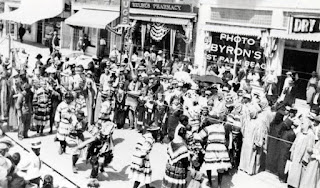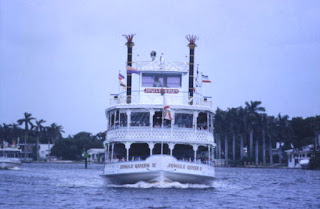 |
| Outlaws 1979 State Archives Florida/Thurston |
By Jane Feehan
It’s hard to believe driving through posh Juno Beach today that it was called home by some of the Outlaws motorcycle gang during the 1960s.
Their hangout drew the personal attention of Florida Gov. Claude Kirk (1926-2011) who rose to the state’s highest office, in part, by claiming to be tough on crime. The flamboyant leader was also known for grabbing headlines for his antics, many unrelated to actual governing.
The Outlaws provided a good crime focus and photo op for the governor during November 1967. Gang members were arrested for allegedly nailing a 19-year-old woman to a tree in Juno. According to news accounts, she may have refused to turn a trick to hand over $10 to her “old man” or boyfriend. They nailed her (with her permission it was reported) to a tree branch with her toes barely touching the ground.
Afterward, news accounts say the cyclists dropped the woman off at a hospital and were thought to have stolen drugs. They were nabbed by police in a camp of trailers and cottages behind Kitty’s Saloon on U.S. Highway 1 in Juno.
Afterward, news accounts say the cyclists dropped the woman off at a hospital and were thought to have stolen drugs. They were nabbed by police in a camp of trailers and cottages behind Kitty’s Saloon on U.S. Highway 1 in Juno.
The Florida Hotel and Restaurant Commission ordered the bar and camp closed calling it a public nuisance. Law enforcement then led a raid on the site to clean up ongoing gang activities.
The owner of the saloon who also lived in the camp (and later was arrested on suspicion of running a prostitution ring), told reporters she was sure Gov. Kirk was present during the raid. “I guess you know I’m the governor,” the mysterious visitor told her, shaking her hand.
He said he didn’t want any publicity.
Three weeks later, Kirk was at the closed Kitty’s Saloon with Palm Beach Sheriff William R. Heidtman to temporarily reopen it for a Life Magazine photographer. Kirk’s photo was taken as part of a story to be published by the magazine about the Outlaws. Also photographed was the saloon’s interior with the sign, "Cycles Rule - Surfers Drool."
Five members of the gang were tried for the nailing incident a year later, the news reported. The Outlaws continued to headline crime news in Florida for twenty more years.
Kirk served one term - 1967 until 1971. He was criticized for not attending to state business but national buzz during those years suggested he could have been tapped as Nixon’s vice-president. To his credit Claude Kirk is recognized as being Florida’s first environmental governor (Grunwald, Michael. The Swamp. New York: Simon & Schuster (2006).
Copyright © 2012. All rights reserved. Jane Feehan.
Sources:
Palm Beach Post, Nov. 10, 1967
Miami News, Nov. 28, 1967
St. Petersburg Times, July 31, 1968
Tags: Juno Beach history, Gov. Kirk, Outlaw gang, Palm Beach history, Palm Beach County crime












